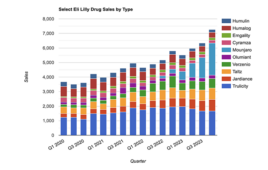
Image from the National Cancer Institute via Unsplash
Biotechnology traces its roots to the Neolithic era when early civilizations discovered how to ferment grains to prepare alcoholic brews and bread. It wasn’t until genetic engineering became mainstream in the mid-1970s, however, that biotechnology, as we know it today, was launched. The field continues to evolve today. The advent of new technology has revolutionized the market in recent years, driving industry expansion.
Putting the biotechnology industry into perspective
The global biotechnology market was valued at $449.06 billion in 2019, mainly dominated by the U.S. and Canada (40%), followed by Europe and Asia.
The market is projected to achieve an 8.3% compound annual growth rate (CAGR) through 2025, reaching a $729 billion valuation.
In Asia-Pacific, the market is expected to have a 9% CAGR over the forecast period, with India and China fueling much of that growth.
China’s biotechnology industry is projected to exceed $60 billion by 2025. In 2018, China already began to take a leading position in terms of patents for new medicines. China files about nine times as many biotech patents as Europe. For the sake of comparison, the U.S. files about three times as many as Europe.
Factors driving growth
One of the chief factors driving market demand for biotechnology products is the growing incidence of chronic ailments such as diabetes and cancer worldwide. Other factors responsible for the field’s growth include improving healthcare access in remote areas, unmet medical needs in certain geographies and growing R&D investment, leading to new applications.
Furthermore, the rising demand for bio-based agricultural products and the growing adoption of biotechnology in clinical research will accelerate market expansion.
A handful of therapeutic areas, in particular, will be vital in driving growth. In these domains, there is a combination of intriguing research, innovative technologies and the promise of transforming the way diseases are treated across the globe.
We have observed biotechnology companies focusing their pipeline on these areas six areas:
- Immuno-oncology.
- Alzheimer’s disease.
- Cell and gene therapy.
- Nonalcoholic steatohepatitis (NASH).
- RNA.
- Rare and orphan diseases.
Recently, of course, COVID 19 has emerged as a therapeutic focus. According to BiotechBourse, 40% of the 20 most significant announcements were related to COVID-19 during the first half of 2020. See the following table:

The 20 most significant Euronext-listed biotech announcements in H1 2020
According to IQVIA and Statista, spending on medicines globally will exceed $1.5 trillion by 2023 — up from $1.3 trillion in 2019. The CAGR in the period will likely be in the range of 3–6%.
Driving a significant proportion of that sum will the U.S., with an estimated $625–655 billion worth of spending on medicines and a 4–7% CAGR. “Pharmerging” countries will drive $355–385 billion of spending and will have a CAGR in the range of 5–8%.
The five largest European countries will have spending in the range of $195–225 billion with a 1–4% CAGR. Finally, Japan will spend $89 to 93 billion with a CAGR of 3% CAGR.
Developed markets will drive the bulk of spending on medicines through 2023, thanks to their demand for a wave of innovative new therapies.
R&D considerations
The global pharmaceutical industry has one of the highest rates of R&D investment. Global R&D for the sector is expected to reach $203.9 billion by 2024 from $165 billion in 2017. In 2024, Roche (SWX:RO) is poised to remain the top spender in 2024, followed by Novartis (NYSE:NVS) and Johnson & Johnson (NYSE:JNJ).
The return on investment for R&D, however, has declined dramatically in the pharma industry in recent years. In 2018, Deloitte suggested that pharma companies observed the lowest return on investment in nine years, at 1.9%, down from 10.1% in 2010. Smaller firms outperformed the giants and have an average 9.3% R&D return.
The cost of commercializing a new drug has almost doubled to around $2.1 billion compared to $1.1 billion in 2010. Therefore, the companies must pump more money in to get reasonable profits. As a result, they are increasingly looking for new ways to improve ROI for R&D spending.
Large pharma companies have been aggressively reshaping their businesses after the patent cliff in the early 2000s, shifting their portfolios to more specialty and niche products. To maintain margins, companies are doubling down on innovation and looking to technology to drive efficiencies.
Pharma companies build on partnerships and collaborations to fuel innovation. Emerging biopharma companies (EBP) with less than $500 million in revenue or less than $200 million in R&D spending are a growing influence in late-stage pipelines and launches. Over the past several years, R&D activity from those companies has increased from 60% in 2009 to 72% in 2018.
EBPs increasingly contribute to innovation, and these companies were the original patentees for 29 of the current top 100 drugs, which accounted for 40% of sales in the United States in 2018. For drugs launched in 2018, emerging biopharma companies were responsible for launching 42% of new drugs, up from 26% in 2017.
EBP-originated products generally reach the market faster if more established companies acquire and launch them. The median time for EBP companies to launch new drugs was 16.6 years in 2018 — more than 30% slower than other company types.
Partnerships between EBPs and larger companies accounted for nine of the top ten partnering deals in 2018, and emerging biopharma companies were involved in seven of the top 10 M&A deals in 2018. There was also a 78% increase in deals at the pre-registration stage, or 62 deals compared with 36 in 2017.
We also observed a new phenomenon — large companies are partnering more often with emerging biopharma companies on launches rather than buying those assets outright. The phenomenon often occurs when the commercial results are less certain, mitigating risks and enabling tighter control over operating costs and margins.
Since 2016, Sanofi (EPA: SAN) has followed a restructuring plan that includes discarding non-strategic activities and acquisitions. The aim is to position the company in strategic areas of oncology, immunology and multiple sclerosis with the purchase of Protein Sciences, Ablynx and Bioverativ. In 2020, Sanofi announced the acquisition of Synthorx, Inc. for $ 2.5 billion. “The acquisition of Synthorx perfectly aligns with our R&D strategy, enhancing our position as an emerging leader in the area of oncology and immunology,” said Paul Hudson, Sanofi’s CEO, in a statement.
In 2016, Bayer started a strategic move in the cell and gene therapy landscape. One of the first steps it took was launching BlueRock Therapeutics with Versant Ventures, which was a $225 million investment. Since 2019, Bayer has accelerated this move by acquiring BlueRock Therapeutics for $600 million to buy the remaining capital, thus valuing BlueRock around $1 billion.
In 2020, Bayer announced the approximately $4 billion acquisition of Asklepios BioPharmaceutical, a U.S.-headquartered biopharmaceutical company specialized in research, development and manufacturing of gene therapies across different therapeutic areas. AskBio’s development portfolio includes investigational pre-clinical and clinical-stage candidates to treat neuromuscular, central nervous system, cardiovascular and metabolic diseases.
The first two quarters of 2020 have not been favorable for deals, according to Evaluate and PwC. Pharma deals increased from 19 transactions in the first quarter of the year to 22 transactions in the second quarter. The total value of acquisitions was $3.3 billion in the second quarter of 2020 — the lowest since the first quarter of 2018.
Biotech landscape deal values were flat in the first and second quarters of 2020 at $6.3 billion. That sum was the lowest level since the second quarter of 2017, partially driven by relative strength in biotech capital markets.
There was only one biotech megadeal in the first quarter of 2020: Gilead acquired Forty Seven for $4.9 billion.
Sizing up COVID-19’s impact
But some biopharma executives don’t think COVID-19 is changing how companies think of M&As. “The appetite for merger and acquisition or any externalization activities is not significantly adjusted at Takeda as the result of current health disruption,” said Evan Lippman, head of corporate development, M&A and valuation for TakedaPharmaceuticals (NYSE: TAK).
Nevertheless, COVID-19 is hurting clinical trial enrollment and has delayed some data readouts.
In the first half of 2020, COVID-19 seems not to be affecting the U.S. biotech IPO landscape. More than 26 biotech IPOs have been completed, the average performance after the IPO is a gain of 21%. Companies focusing on COVID-19 tend to perform best.
In May, the 61 European biotechs on the Euronext markets have seen their total market capitalization increase by €4.5 billion, reaching an all-time high of nearly €29 billion. Their share price recorded an increase of 66.8% in the first half of 2020. The COVID-19 health crisis has had an impact on companies’ valuation in the biotech landscape. The 14 companies focusing on diagnostics, treatments and vaccines of COVID-19 have seen their valuation increase by an average of 200.5% since the beginning of the year, compared with 17.1% on average for the 47 other biotech companies during the first half of 2020.
Novacyt or Biotech Pharmacon, for instance, have seen gains of 1,983% and 532%, respectively This evolution is a result of announcements related to COVID-19. There were 33 positive announcements during the first half of the year, with an average increase of 42.9% per announcement. There were only six negative announcements. The average loss for those six companies was 28.1%.
In the fight against COVID-19, biotech companies seem to be the biggest winner at the moment. Moderna (NASDAQ:MRNA) and Pfizer (NYSE:PFE) and its partner BioNTech, for example, have reported vaccines that are 94.5% and 95% efficacious, respectively. This success brings three strategic pillars to those companies: The first one is revenue.
If Moderna’s can get FDA approval and can make enough doses, its top line could be nearly $35 billion higher than the $250 million in revenue it generated in the past 12 months, according to experts. The second pillar is valuation. Those companies’ share prices are at an all-time high. Finally, this success increases companies’ brand name regarding innovation capabilities and pricing power for future drugs because these vaccines are a common good for humanity.
COVID-19 has had less of an impact on the global pharmaceutical sector than other industries such as the airline and tourism sectors. The biotech market continues to grow, and its increasing fortunes drive innovation and strategic alliances and M&A at large pharma companies. Biotech players are poised to be the biggest winners in the long run, even if deals and clinical trials have been affected recently.
 Joseph Pategou is a consultant specializing in the pharmaceutical industry who has published more than 30 articles in reputable journals, including Biosimilar Development, The Indian Economist, Labotech.eu and others. You can connect with and follow him on LinkedIn or Twitter.
Joseph Pategou is a consultant specializing in the pharmaceutical industry who has published more than 30 articles in reputable journals, including Biosimilar Development, The Indian Economist, Labotech.eu and others. You can connect with and follow him on LinkedIn or Twitter.
Sources
- https://www.labiotech.eu/gene-cell-therapy/gene-therapy-askbio-bayer/
- https://www.usinenouvelle.com/article/la-course-aux-biotech-se-poursuit-pour-les-grands-laboratoires-pharmaceutiques.N920079
- https://www.gminsights.com/industry-analysis/biotechnology-market
- https://www.polarismarketresearch.com/industry-analysis/biotechnology-market
- https://www.mckinsey.com/industries/pharmaceuticals-and-medical-products/our-insights/biotech-in-europe-a-strong-foundation-for-growth-and-innovation
- https://www.euronext.com/en/news/biotech-barometer-h1-2020
- https://www.biospace.com/article/releases/biotech-showcase-highlights-six-therapeutic-areas-garnering-attention-for-investment-in-2019/
- https://www.statista.com/statistics/263102/pharmaceutical-market-worldwide-revenue-since-2001/#:~:text=As%20of%20end%2D2019%2C%20the,just%20390%20billion%20U.S.%20dollars.
- https://www.iqvia.com/insights/the-iqvia-institute/reports/the-global-use-of-medicine-in-2019-and-outlook-to-2023
- https://www.prnewswire.com/news-releases/why-pharmaceutical-rd-global-spending-could-exceed-200-billion-by-2024-300973308.html
- https://www.prescouter.com/2019/06/pharmaceutical-rd-global-spending-trends-in-2019/
- https://www.statista.com/statistics/309471/randd-spending-share-of-top-pharmaceutical-companies/
- https://www.statista.com/statistics/309466/global-r-and-d-expenditure-for-pharmaceuticals/#:~:text=Total%20global%20pharmaceutical%20R%26D%20spending%202012%2D2026&text=In%202019%2C%20research%20and%20development,136%20billion%20dollars%20in%202012.
- https://www.pmlive.com/pharma_news/pharmas_r_and_d_productivity_sinks_to_a_new_low_1273354
- https://www.fiercepharma.com/pharma/bio-covid-19-changing-how-biopharmas-think-m-as-not-really-say-j-j-and-takeda-execs
- https://www.pwc.com/gx/en/services/deals/trends/pharmaceuticals-life-sciences.html
- https://www.fiercepharma.com/pharma/pharma-deal-values-plummet-56-first-half-as-covid-19-disrupts-resources-report
- https://www.euronext.com/en/news/biotech-barometer-h1-2020
- https://biotechbourse.fr/une-biotech-a-ete-introduite-chaque-semaine-aux-etats-unis-au-premier-semestre-2020/
- https://www.fiercepharma.com/pharma/bio-covid-19-changing-how-biopharmas-think-m-as-not-really-say-j-j-and-takeda-execs
- https://www.evaluate.com/vantage/articles/data-insights/ma/biopharma-acquisitions-slow-its-not-covid-19s-fault-yet
- https://www.evaluate.com/vantage/articles/data-insights/ma/big-pharma-sports-smallest-late-stage-pipeline-decade
Filed Under: clinical trials, Drug Discovery, Drug Discovery and Development, Infectious Disease, Neurological Disease, Oncology, Orphan Drugs





Tell Us What You Think!
You must be logged in to post a comment.